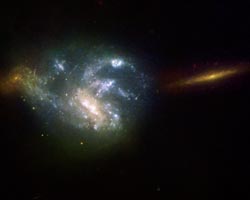
The Hubble Space Telescope bears witness to incredibly intense star formation in this image of NGC 7673 in Pegasus. The blue knots are regions where millions of new stars are igniting.
Courtesy European Space Agency and Nicole Homeier.
Our universe is the ultimate laboratory to study the life cycle of stars. At any given moment, examples of every stage of stellar evolution — supernovae, main sequence stars, white dwarfs, and seedling gas clouds — are easily within view.
Included in this tapestry are stellar nurseries, and among the most visually stunning of these birthing grounds is NGC 7673. Between 1996 and 1997, the Hubble Space Telescope took this mosaic image of the distorted spiral galaxy in Pegasus. Released this week, the image shows that the blue-light knots are, in fact, clusters of intense star formation. The infant stars glow with brilliant ultraviolet radiation, gushing their energy uncontrollably like a baby rattlesnake spews venom.
Nicole Homeier (European Southern Observatory) and her colleagues are using this image to determine what could have triggered the baby boom in NGC 7673. The most-favored scenario involves the close flyby of a passing galaxy, which would have triggered a rash of star formation by shaking the galaxy to its core. Another possibility is that there are dynamics within the spiral galaxy itself that are not well understood, such as instabilities in the distribution of gas within the star-forming knots.
 0
0
Comments
You must be logged in to post a comment.